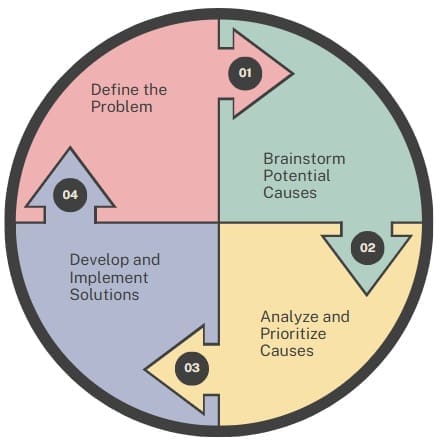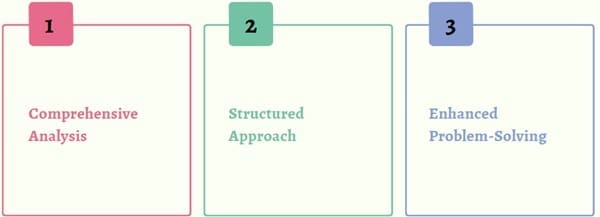The 6Ms are a problem-solving tool used in the manufacturing and service industries to systematically explore and identify the root causes of problems. These six categories—Manpower, Methods, Machines, Materials, Mother Nature, and Measurement—help break down complex issues into smaller, manageable factors.
By doing so, organizations can address problems more effectively and find lasting solutions. The 6Ms are particularly useful when creating a Cause-and-Effect Diagram, also known as a Fishbone or Ishikawa diagram, which visually organizes potential causes of a problem.
The 6Ms allow a deeper look into the internal and external factors that affect business processes. They provide a structured approach that encourages team members to explore each facet of a problem and separate causes that influence the issue.
Through this systematic method, you can pinpoint areas that need improvement and work towards solutions that reduce inefficiency, minimize defects, and improve the overall quality of products or services.
Table of contents
Understanding the 6Ms
The 6Ms represent six core categories, each focused on a key area of organizational or operational performance. Let’s dive into each category to understand its role and significance.

Manpower (People Power)
Manpower refers to the human resources involved in the process. This category addresses the skills, knowledge, training, and engagement levels of employees. It also considers the organizational structure, job roles, and how well employees are working together to meet goals. When applying the 6M method, questions to ask might include:
- Are employees trained adequately for their roles?
- Do workers have the necessary technical expertise?
- Is there a high level of employee engagement and motivation?
- Are employees following the correct procedures or best practices?
- How is teamwork and communication within the team?
Issues within the manpower category may include improper training, a lack of motivation, insufficient staffing, or poor communication between teams. Identifying these issues can help ensure that the right people are in the right roles and that they have the tools and support needed to succeed.
Example in Practice: In a factory setting, a skilled operator might be absent for a shift, leaving a less experienced worker to take over. The machine might malfunction due to improper handling, leading to delays or defects. In this case, we can identify the manpower issue—lack of training or a gap in staffing—as a contributing cause to the problem.
Machines (Tools, Equipment, and Technology)
The machinery category encompasses all the tools, equipment, and technology used in the production process. These resources are integral to completing tasks, and their performance directly impacts the efficiency and quality of the output. Key considerations when evaluating machines include:
- Are machines well-maintained and serviced regularly?
- Are there frequent breakdowns or malfunctions that disrupt production?
- Are the machines suitable for the tasks at hand?
- Is there a lack of necessary equipment to meet production demands?
When companies do not properly maintain or update machines, they can cause inefficiencies, downtime, or defects. The machinery category also looks at the adequacy of the tools, whether they are functioning as designed, and whether the current equipment is up to industry standards.
Example in Practice: A company may face delays due to a malfunctioning conveyor belt. Inadequate maintenance and the lack of a preventive maintenance schedule trace the issue back. This points to the machine category as the root cause, which we can address by implementing a robust maintenance plan and ensuring the equipment is up to par.
Materials (Raw Materials and Consumables)
The materials category focuses on the raw materials, components, and consumables used in the production process. This includes evaluating the quality, availability, handling, and storage of materials. Key aspects to consider include:
- Are the materials sourced from reliable suppliers?
- Are the materials of the correct quality for the intended use?
- Is the inventory properly managed to avoid shortages or overstocking?
- Are materials stored appropriately to prevent degradation or contamination?
Poor quality materials or issues with material supply can cause delays, defects, or production stoppages. Materials may also be wasted if not handled or stored properly, leading to inefficiencies. A systematic approach to materials management is crucial to maintaining the quality of finished products.
Example in Practice: In a food manufacturing company, raw ingredients might spoil due to improper storage conditions. If the company does not control the temperature and humidity correctly, it can lead to mold growth or other quality issues. Here, materials management and proper storage practices would be key areas to address.
Methods (Processes and Procedures)
Methods refer to the procedures, techniques, and processes used in production or service delivery. This category examines how work is done and if the existing processes are efficient, standardized, and effective. It addresses:
- Are the processes well-documented and consistently followed?
- Are there any inefficiencies or bottlenecks in the workflow?
- Is there room for process improvement or simplification?
- Are workers using the best available methods, or is there a reliance on outdated practices?
Processes can often become convoluted, leading to wasted time or unnecessary steps that do not add value. The method category streamlines processes and ensures that everyone follows best practices. This evaluation also includes identifying areas where new methods or technologies could improve productivity and quality.
Example in Practice: A software development company may struggle with delays because of cumbersome, outdated coding practices. Introducing agile methodology, training employees, and adopting modern tools could address these inefficiencies in methods.
Analyzing the method category through the 6M approach would help streamline workflows and improve overall performance.
Mother Nature (Environmental Factors)
The mother nature category considers external factors that influence the production process, including uncontrollable environmental variables. These factors can be natural or man-made and include weather conditions, temperature, humidity, and even geographic location. Key aspects include:
- Are there any environmental factors affecting the production process?
- Does the facility have adequate controls for environmental factors like temperature or humidity?
- Is the production process sensitive to weather or other unpredictable environmental variables?
Unpredictable environmental changes can disrupt processes and lead to product quality issues. Being aware of environmental conditions and mitigating risks where possible helps ensure a smoother production process.
Example in Practice: In construction, weather conditions such as rain or extreme heat can delay projects. The company may have to reschedule work or adjust its timelines. Understanding the impact of weather on operations allows businesses to plan for potential disruptions and avoid delays.
Measurement (Inspection and Data Collection)
Measurement involves the systems used for inspection, testing, and evaluating product quality. Accurate measurement is essential to detect defects and ensure product specifications are met. Considerations include:
- Are measurement instruments calibrated correctly?
- Are quality checks performed at regular intervals?
- Are measurement data accurately recorded and analyzed?
- Is the inspection process thorough enough to catch all defects?
Measurement helps assess whether products meet the required standards and specifications. Issues in measurement could include incorrect calibration, faulty equipment, or ineffective inspection processes. Inaccurate measurements can lead to poor product quality or compliance issues.
Example in Practice: A company producing electronic components might face issues if it improperly calibrates its measurement tools. This could lead to faulty products passing inspection, leading to customer complaints. Regular calibration and proper measurement protocols can help avoid such problems.
Applying the 6Ms

To utilize the 6Ms effectively, follow these steps:
- Define the Problem
Clearly articulate the issue you are facing. A well-defined problem sets the stage for effective analysis. - Brainstorm Potential Causes
Gather a team to discuss and list possible causes under each of the 6M categories. Encourage open communication to uncover all potential factors. - Analyze and Prioritize Causes
Evaluate the identified causes to determine their impact and likelihood. Prioritize them based on their significance to the problem. - Develop and Implement Solutions
Create action plans to address the most critical causes. Implement these solutions and monitor their effectiveness.
Benefits of Using the 6Ms

- Comprehensive Analysis
By examining all potential areas, the 6Ms ensure a thorough investigation of the problem. - Structured Approach
The methodical categorization helps in organizing thoughts and discussions, leading to clearer insights. - Enhanced Problem-Solving
Identifying root causes allows for targeted interventions, improving overall process efficiency.
Challenges and Considerations
While the 6Ms is a powerful tool, it requires active participation from all team members. Without proper engagement, the analysis may overlook critical factors. Additionally, accurate data and a clear understanding of the process being analyzed determine the effectiveness of the 6Ms.
Final Words
The 6Ms, or Ishikawa Diagram, is a valuable tool for organizations seeking to identify and address the root causes of problems. By systematically analyzing Manpower, Methods, Machines, Materials, Measurement, and Mother Nature, businesses can implement effective solutions that enhance quality and efficiency.


















